Raphaelle Peale
Raphaelle Peale (sometimes spelled Raphael Peale) (February 17, 1774 – March 4, 1825) is considered the first professional American painter of still-life.

Biography
Peale was born in Annapolis, Maryland, the fifth child, though eldest surviving, of the painter Charles Willson Peale and his first wife Rachel Brewer. He grew up in Philadelphia, and spent his life there in a home at the corner of 3rd and Lombard. Like his siblings (almost all of whom were named after famous artists or scientists), Raphaelle was trained by his father as an artist. Early in his career, the pair collaborated on portraits. On some commissions, Raphaelle painted miniatures while his brother, Rembrandt, painted full-size portraits.
In 1793, he made a trip to South America in order to collect specimens for the Peale Museum founded by his father.[1] He exhibited five portraits and eight other paintings, probably still lifes, at the Columbianum, Philadelphia in 1794.[2] His first professional exhibition was in 1795 at the age of 21. In 1797, with his brother Rembrandt, he traveled to Charleston, South Carolina, where they attempted to establish another museum. The plan fell through, however, and Raphaelle returned to painting miniatures.
He married Martha (Patty) McGlathery at the age of twenty, and with her had eight children. For about two years beginning in 1803, Peale toured Virginia with the "physiognotrace", a profile making machine, with which he was briefly successful. By 1806 he had begun to suffer the symptoms of arsenic and mercury poisoning brought on by his work as a taxidermist in his father's museum.[1] In August 1809 he was hospitalized with delirium, and for the rest of his life he suffered debilitating attacks almost yearly—which his father ascribed to "gout of the stomach" caused by consumption of pickles and excessive drinking.[1] From 1810, Peale concentrated on still-life painting almost exclusively, becoming America's first professional still-life painter, and he exhibited frequently at the Pennsylvania Academy of the Fine Arts and elsewhere, especially from 1814–18.[2] By 1813, he was unable to walk without crutches.[1] After the downturn in his health, in an era when most artists considered still life a subject worthy only of amateurs, he devoted himself almost exclusively to still life painting. It is for these works he is best known. His work was on frequent exhibit at the Pennsylvania Academy of the Fine Arts between 1814 and 1818. After reportedly indulging in a night of heavy drinking, his health destroyed, he died on March 4, 1825,[1] at age 51 at his home in Philadelphia.
Style
Alfred Frankenstein has called Raphaelle Peale "the first really distinguished still-life specialist to emerge in this country, and he is one of the four major still-life painters of the nineteenth century in the United States."[3] His style may have been influenced by Spanish still life paintings he saw on his trip to Mexico and by the two works by Juan Sanchez Cotan, exhibited at the Pennsylvania Academy in 1816.[1] Most of Peale's paintings are small in scale, and depict a few objects—usually foodstuffs—arranged on a tabletop before a darkened background. A notable exception is his trompe l'oeil, Venus Rising from the Sea—A Deception (also entitled After the Bath, 1822, in the collection of the Nelson-Atkins Museum of Art).[4]
It was his nephew George Escol Sellers's opinion that Raphaelle Peale was the most talented of Charles Wilson Peale's artist children and that "it was the Revolution that made him the wreck he was".[5]
Major works
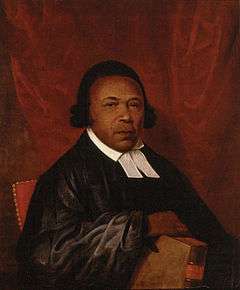 Portrait of Absalom Jones, 1810, Delaware Art Museum
Portrait of Absalom Jones, 1810, Delaware Art Museum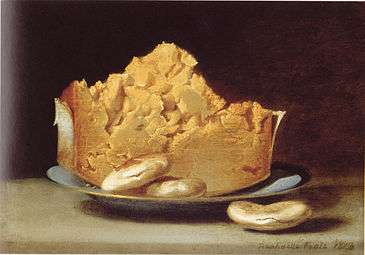 Cheese with three crackers, 1813
Cheese with three crackers, 1813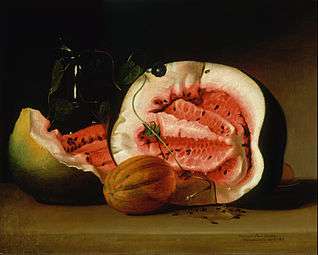 Melons and Morning Glories, 1813
Melons and Morning Glories, 1813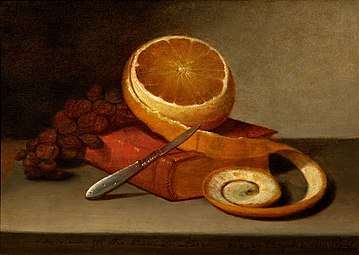 Still Life with Orange and Book, 1815
Still Life with Orange and Book, 1815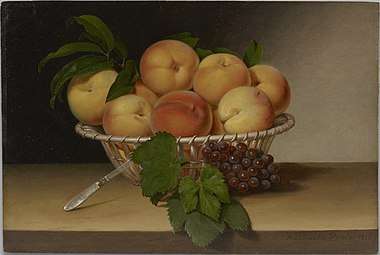 Still Life: Basket of Peaches, 1816
Still Life: Basket of Peaches, 1816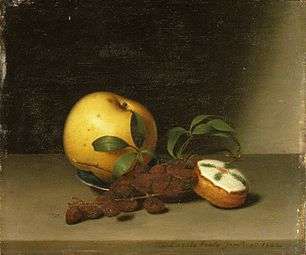 Still Life with Cake, 1816
Still Life with Cake, 1816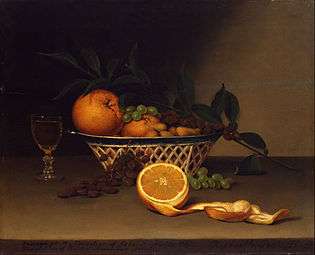 Still Life with Oranges, 1818
Still Life with Oranges, 1818.jpg) Still Life with Cake, 1818, Metropolitan Museum of Art
Still Life with Cake, 1818, Metropolitan Museum of Art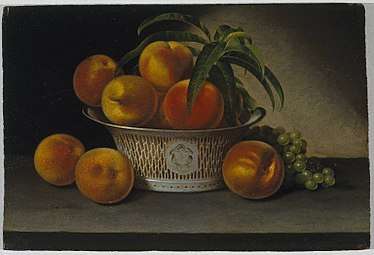 Still Life with Peaches, 1821
Still Life with Peaches, 1821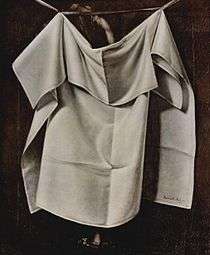 Venus Rising from the Sea – A Deception, 1822
Venus Rising from the Sea – A Deception, 1822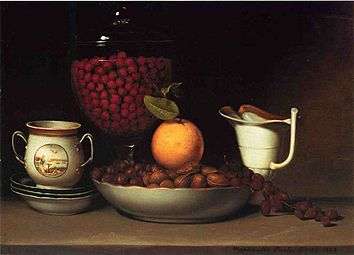 Still Life: Strawberries, Nuts &c., 1822
Still Life: Strawberries, Nuts &c., 1822
- Blackberries, c. 1813
- Melons and Morning Glories, 1813
- A Dessert (Still Life with Lemons and Oranges), 1814
- Still Life with Orange and Book, 1815
- Fruit, Pitcher, and Pretzel, unknown
- Bowl of Peaches, 1816
- Still Life with Fruit, Cakes and Wine, 1821
- Still Life with Peaches, 1822
- Lemons and Sugar, unknown
Notes
- Lloyd 1988.
- Smithsonian American Art Museum collection record, citing William Kloss, Treasures from the National Museum of American Art (Washington, D.C. and London: National Museum of American Art with the Smithsonian Institution Press, 1985)
- Frankenstein, p. 32.
- Conrads, Margaret C. (2007-01-01). American Paintings to 1945 : The Collections of The Nelson-Atkins Museum of Art. The Nelson-Atkins Museum of Art.
- Cikovsky, Nicolai, Jr.; Bantel, Linda; Wilmderding, John. Raphaelle Peale Still Lifes (PDF). New York: National Gallery of Art, Washington; Pennsylvania Academy of the Fine Arts, Philadelphia; Distributed by Harry N. Abrams, Inc. pp. 115–16. Retrieved March 26, 2017.
... . Uncle Raphael . . . was in reality the most talented of Grandpa's sons and it was the Revolution that made him the wreck he was.
References
- Frankenstein, Alfred, The Reality of Appearance, Greenwich: New York Graphic Society, 1970. ISBN 0- 8212-0357-6
- Lauren Lessing and Mary Schafer, “Unveiling Raphaelle Peale’s Venus Rising from the Sea – A Deception,” Winterthur Portfolio 43 (July/August 2009), 229–59. http://www.jstor.org/stable/10.1086/600814 32 pages
- Phoebe Lloyd, "Philadelphia Story", Art in America, (November 1988), 154–171, 195–200.
- Margaret C. Conrads, ed., The Collections of The Nelson-Atkins Museum of Art: American Paintings to 1945, vol. 1: https://archive.org/details/americanpainting01conr
- Margaret C. Conrads, ed., The Collections of The Nelson-Atkins Museum of Art: American Paintings to 1945, vol. 2: https://archive.org/details/americanpainting02conr_1
External links
| Wikimedia Commons has media related to Raphaelle Peale. |
- Raphaelle Peale at Artcyclopedia.com
- "Raphaelle Peale (1774–1825) Artwork Images, Exhibitions, Reviews" (list of works), World Wide Arts Resources, 2007, webpage: WWAR-RPeale.
- "The Metropolitan Museum of Art – Works of Art: American Paintings" (history), Metropolitan Museum of Art, 2007, webpage: MMA-RPeale.
- Birmingham Museum of Art, A Portrait of Margaret George McGlathery, 1817
- Raphaelle Peale from the Smithsonian American Art Museum.